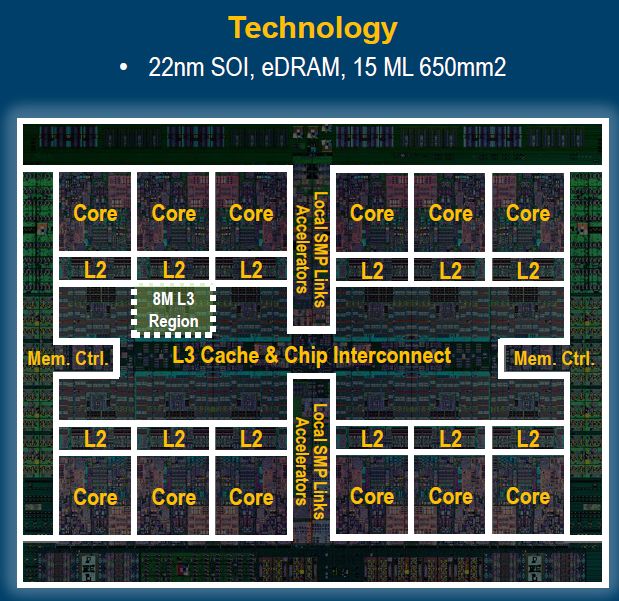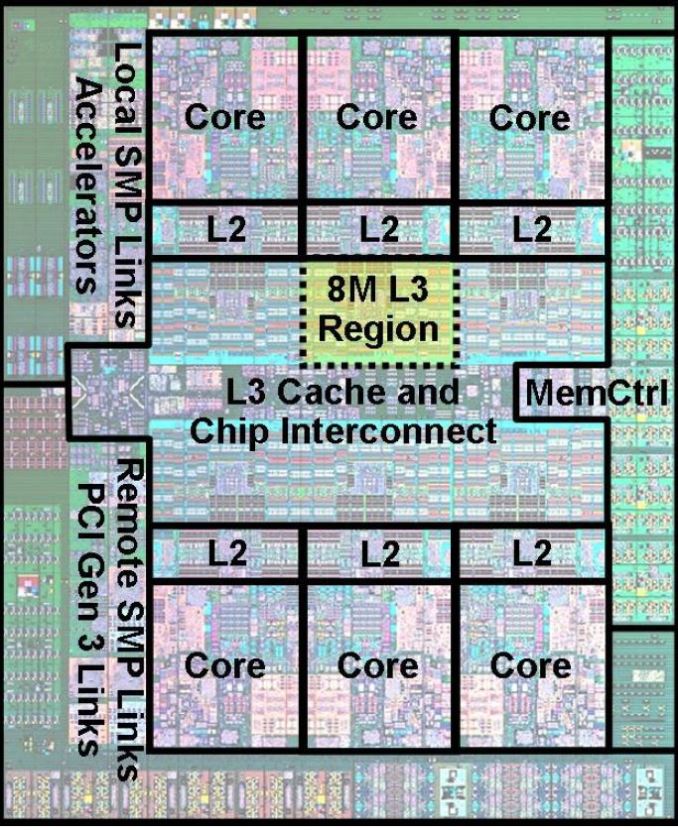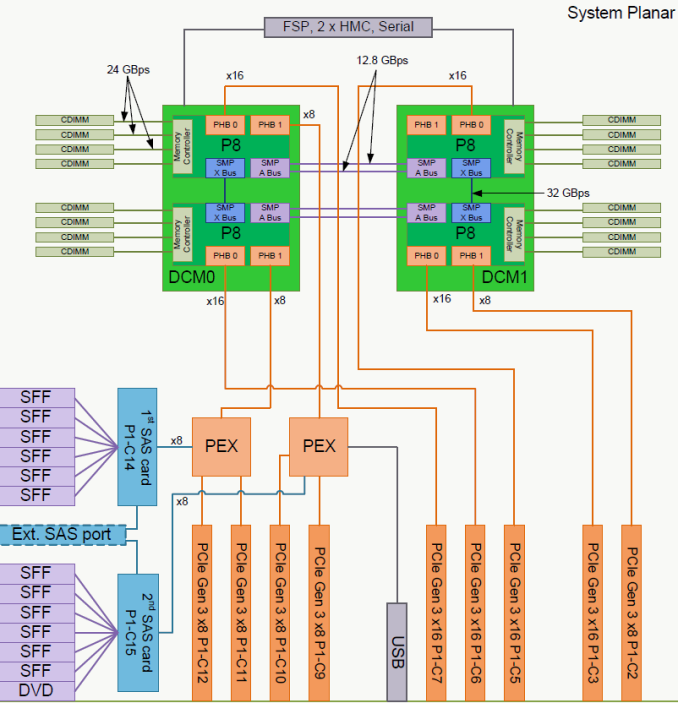The IBM POWER8 Review: Challenging the Intel Xeon
by Johan De Gelas on November 6, 2015 8:00 AM EST- Posted in
- IT Computing
- CPUs
- Enterprise
- Enterprise CPUs
- IBM
- POWER
- POWER8
Inside the S822L: Hardware Components
The 2U Rack-mount S822L server contains two IBM POWER8 DCM sockets. Each socket thus contains two cores connected by a 32GBps interconnect. The reason for using a Multi-Chip-Module (MCM) is pretty simple. Smaller five-to-six core dies are a lot cheaper to produce than the massive 650 mm² monolithic 12-core dies. As a result the latter are reserved for IBM's high-end (E880 and a like). So while most POWER8 presentations and news posts on the net talk about the multi-core die below...
... it is actually an MCM with two six core dies like the one below that is challenging the 10 to 18 core Xeons. The massive monolithic 10-12 core dies are in fact reserved for much more expensive IBM servers.
The layout of the S822L is well illustrated by the scheme inside the manual.
Each DCM offers 48 PCIe Gen 3 lanes. 32 of those lanes are directly connected to the processor while 16 connect to PCIe switches. The PCIe switches have "only" 8 lanes upstream to the DCM, but offer 24 lanes to "medium" speed devices downstream. As it unlikely that both your SAS controllers and your network controllers will gobble up the full PCIe x8 bandwidth, this is a very elegant way to offer additional PCIe lanes.













146 Comments
View All Comments
extide - Friday, November 6, 2015 - link
No he meant that in a lot of the european countries they use the dot as a comma, so it would be 50.000 to mean 50 thousand.Murloc - Sunday, November 8, 2015 - link
the international system dictates that , and . are the same thing, and as a separator you should use a space.In many countries in Europe, ' is also used. That's fine too as there is no ambiguity.
Using . and , for anything that is not the decimal separator in international websites just creates confusion imho.
I guess AT doesn't have a style book though.
duploxxx - Friday, November 6, 2015 - link
nice review.but Xeon is not 95% of the market. AMD is still just a bit above 5% on its own. so it deserves a bit salt :) not to mention the fact that competition is good for all of us. if reviewers continue like this all narrowed readers will think there is no competition.
silverblue - Friday, November 6, 2015 - link
I'm left wondering what a Steamroller-based 16+ core CPU would do here, considering multithreading is better than with previous models. Yes, the Xeons have a large single-threading lead, but more cores = good in the server world, not to mention that such a CPU would severely undercut the price of the competition.Shame it isn't ever going to happen!
lmcd - Friday, November 6, 2015 - link
Or even an Excavator! It's a shame AMD didn't just keep Bulldozer developing internally until at least Piledriver, and iterate on Thuban.Kevin G - Saturday, November 7, 2015 - link
AMD killed off both Streamroller and Excavator chips early on as the Bulldozer and Piledriver chips weren't as competitive. More importantly, OEMs simply were not interested even if those parts were upgrades based upon existing designs. Thus the great AMD server drought began as they effectively have left that market and are hoping for a return with Zen.Also I should point out that Seattle, AMD's first ARM based Opteron has yet to arrive. This was supposed to be out a year ago and keep AMD's server business going throughout 2015 during the wait for Zen and K12 in 2016. Well K12 has already been delayed into 2017 and Seattle is no where to be found in commercial systems (there are a handle of Seattle developer boards).
JoeMonco - Saturday, November 7, 2015 - link
When you account for only 5% of the market while the other side commands 95%, you aren't really much of a credible competitor.xype - Sunday, November 8, 2015 - link
That’s not always correct, though. You can have 5% of the market and 20% of the profits, for example, which would put you in a way better position than your competitors (because only a small increase in market share would pay big time).Murloc - Sunday, November 8, 2015 - link
that applies more to consumer products, e.g. apple.dgingeri - Friday, November 6, 2015 - link
I've been dealing with IBM Power based machines for 5 years now. Such experience has only given me a major disdain for AIX.I do NOT advise it for anyone. It sucks to work on. There is a certain consistent, spartan logic to it, but it is difficult to learn, and learning materials are EXTREMELY expensive. I never liked the idea of paying $12,000 for a one week class that taught me barely a tenth of what I needed to know to run an AIX network. (My company paid for the class, but I could not get them to pay for the rest of them, for some reason.) This makes people who can support AIX extremely expensive to employ. Figure on paying twice the rate of a Windows admin in order to employ an AIX admin. Then there is the massive expense of maintenance agreements. Even the software only maintenance agreement, just to get patches for AIX, is $4000 per year per system. They may be competitive in cost up front, but they drain money like vampires to maintain.
Even the most modern IBM Power based machine takes 20-30 minutes to reboot or power up due to POST diagnostics. That alone is annoying enough to make me avoid AIX as much as I can.